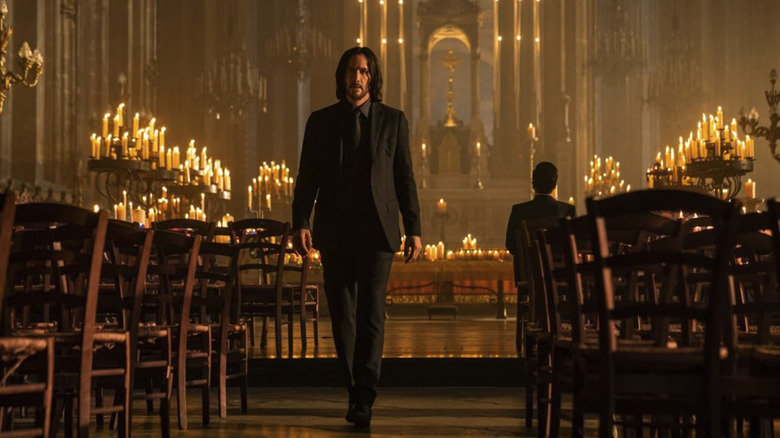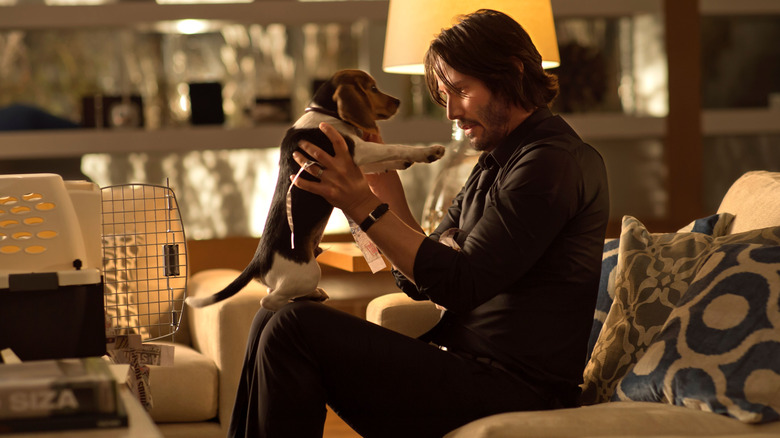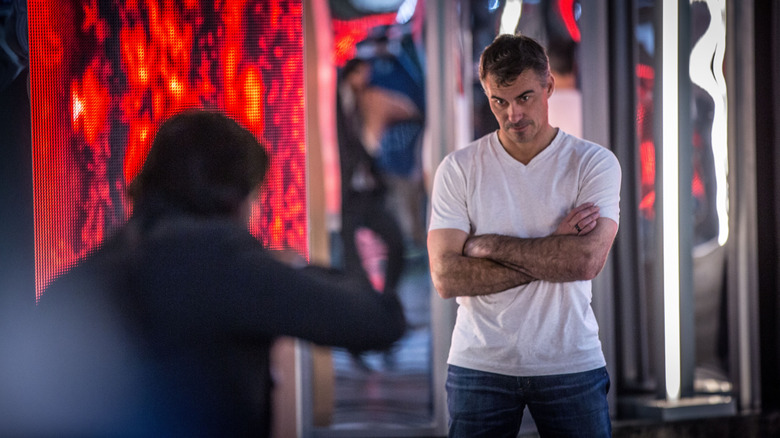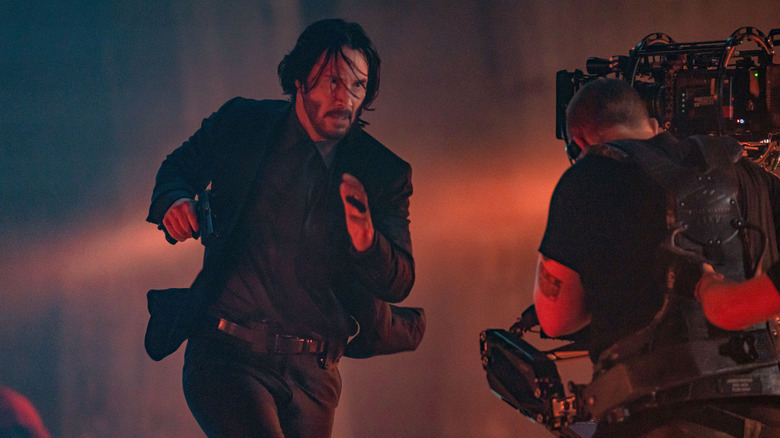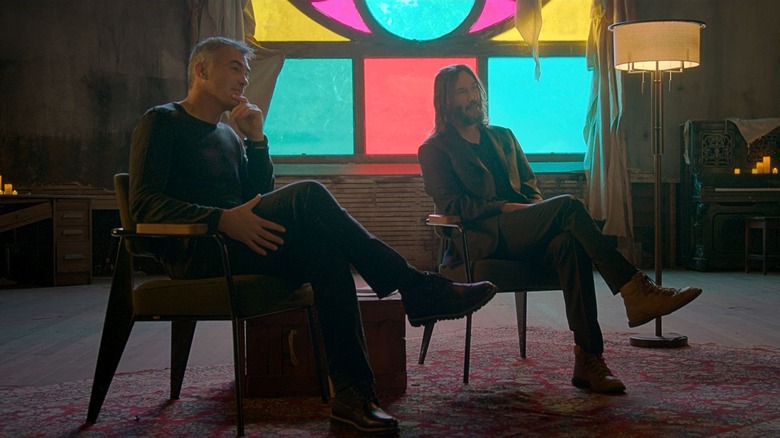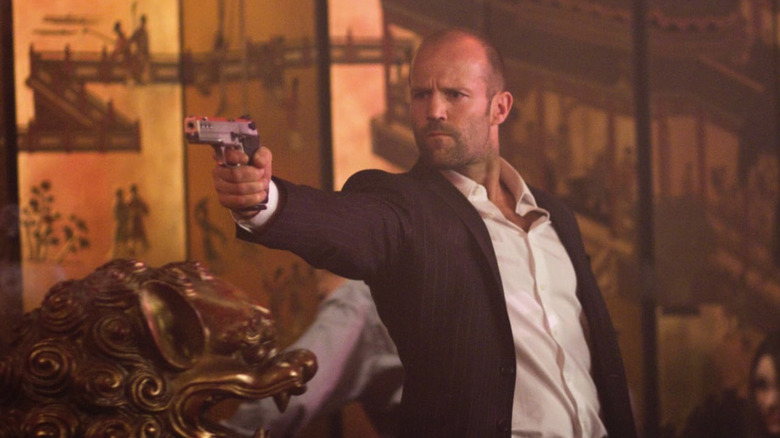John Wick 5 Will Pay Tribute To One Form Of Action Cinema The Series Has Avoided [Exclusive Interview]
Can anything truly worthwhile be achieved without at least a little bit of pain?
That's the question at the heart of a terrific new documentary called "Wick is Pain," which chronicles the unlikely journey of "John Wick" from a spec script called "Scorn" into an indie movie that nearly didn't get made, then into a film that almost went direct-to-video, and finally into a game-changing action franchise that has multiple spin-offs on the way and a fifth entry in the works.
It's a compelling, complicated question, one that's been explored on screen many times and to exceptionally wonderful effect in 2014's "Whiplash," which came out the first year as the original "Wick" film (and specifically in an ending that made our list of favorite movie moments of the 2010s). "Wick is Pain" engages with this conundrum while also taking viewers through a whirlwind introduction to Chad Stahelski and David Leitch, the co-directors of the first film, who then famously split and began working on their own movies. (Stahelski has directed every other "Wick" chapter by himself, while Leitch has directed "Atomic Blonde," "Deadpool 2," "Hobbs and Shaw," "Bullet Train," and "The Fall Guy.") The documentary gets into it all: Why those two guys went their separate ways, the punishment that the actors and stunt performers have taken in order to make the "John Wick" movies as amazing as they are, and much, much more. It features interviews with all the major players, including star Keanu Reeves, and ultimately is a revealing, kick-ass look at the challenges of elevating this unlikely franchise into the action movie pantheon. I loved watching it.
I had a chance to speak with producer Josh Oreck (whose company, Narrator, produced this doc) and executive producer/interview subject Chad Stahelski about the challenges of getting this film made, the big question at the center of it, what Stahelski has in store for "John Wick 5," and more.
Note: This interview has been lightly edited for clarity and brevity.
The John Wick directors almost directed something very different instead
Josh, I want to start with you. I was looking at your IMDb, and I was shocked at just the sheer number of projects that you've worked on over the years. You've had a front row seat to tons of movies, as you've made behind the scenes documentaries and featurettes and things like that, so what did you learn from those experiences that you were able to apply when it came time to produce "Wick is Pain?"
Josh Oreck: I learned that I'm very interested in process, I'm very interested in just allowing things to be what they are, and trying to present them in an honest light. And I think that the core project that I have constantly come back to is this formative experience that I had working on "The Matrix" with Chad and Keanu and David Leitch [Note: Leitch and Stahelski worked as stunt performers on that film], and what that project put out into the world afterwards, which includes "John Wick," and all David Leitch's films, and all the Wachowskis' films. I feel like I've just followed all these incredible people through their process, through really a bunch of incredible careers that are all about trying to find cool and interesting ways of expressing themselves in cinema. So, I've just been really lucky to have real friends in people like Chad and Keanu, who have allowed me to just be a fly on the wall for real, and not necessarily shield themselves from things that might at first glance look bad. Because to me nothing looks bad, it just looks honest.
Chad, at one point, "John Wick" producer Basil Iwanyk says in an interview in this movie that you and David Leitch were close to directing a "Midnight Run"-style movie starring Jean-Claude Van Damme and Psy from "Gangnam Style." What do you remember about that project?
Chad Stahelski: Nothing. [laughs] Look, we are up for a couple different things. The industry works very different than most people think. It's not like there's these big Hollywood power lunches, and they're looking for Chad and Dave to ... You kind of have to hat in hand, go around knocking on doors to different really small, independent producers and production companies and studios, and hope somebody's going to be either nice enough or dumb enough to give you a shot, two guys that just haven't done anything. We had a fairly good reputation as stunt coordinators and choreographers and second unit directors at the time. So, there were a few things, but they were not any smaller or bigger than "John Wick," really. Just different. It was what you'd consider some of the '80s lower budget stuff, that were more about "just get them done and try to sell them in a foreign sales model" or something like that.
With the way it was packaged, whether it was cast or crew, money, budget, storyline, they probably ... it's weird, even at that low budget level, it wasn't going to give us a lot of creative freedom. No one was trying to reinvent anything. It was "make a widget." And because we were very good at speed and shooting and the logistics of filming from our second unit careers, people believed that we would be very quick and efficient with the money, which I believe we would've been, but it would be more about can we achieve it in the time and the money we have, and not completely suck? And we were kind of looking for something — we didn't think budget influenced good or bad, we just were looking for the right one that we could use what little money we had to do what we thought would be noticeable.
Gotcha.
Chad Stahelski: And we never did find that, by the way. We looked, we tried. Most people don't realize how "John Wick" happened is. It wasn't us going to Keanu. Keanu had been attached to the script with Basil, and then for ... you'd have to ask Keanu about how it came about. But a decision was made to call me to talk about some of the action, and Keanu offered me the job of directing the movie. So, he was the one that blessed it enough to give us a shot.
Wick is Pain asks if greatness requires suffering
There's this throughline in the film about how you and Keanu are really pushing yourselves and your collaborators to the point of suffering, and that's where this greatness comes from. I suspect that approach is just in your DNA, given your stunt background and all the projects that you've worked on over the years. But you acknowledge at one point in this doc that maybe that masochistic way of attacking the work maybe isn't the healthiest thing because it led to your divorce, and I was just curious if you've ever thought about what a "Wick" movie might look like without that approach?
Chad Stahelski: If you print anything, you need to print this: I got divorced because I was an a**hole. I didn't get divorced because of a movie. It doesn't quite work that way. I'm not going to hide behind a work.
Look, what's commitment to you? Is commitment suffering? If you're not committed, or if you don't love it, it feels like suffering. If you're committed and you love it, is it suffering or is it just hard work? I love to climb, so I'm climbing for the view, but I'm climbing because I like the pain. I like to climb, I like to know that I'm testing myself, that I can do it. So, for me, working a 14-hour, 15-hour day for something I love, for something I've created, that's life. That's the greatest achievement you can ever do, is you are working for yourself, trying to create something from your mind, with people you love and people that are on board with you.
Now, if you're a crew member and it's just doing it for the paycheck, it sure feels a little bit harder. That's always the leadership quality you need as a director — you need to get everybody to make it feel like it's part of their world, it's their project, it's something everybody can be proud of. You don't want anybody to really suffer. What we really say with pain is, it's opportunity cost. Going to the gym f***ing hurts, doesn't it?
Yep.
Chad Stahelski: Getting up at 5:00 AM f***ing hurts, doesn't it? But is that a bad pain? Are you testing yourself? Would you feel satisfied, would you feel fulfilled, if it didn't hurt a little bit? Nothing great is easy. And that's not masochistic, is it? It's being driven, it's believing, it's loving what you do, but it's always an opportunity cost. If you're going to spend 18 hours a day on set, you can't walk the dog, play catch with the kids, or cook the wife dinner, can you? In one way, it's incredibly selfish and fulfilling, in another way, it could be painful.
Look, I think I'm pretty good at what I do, but I think I'm still a complete mess in life. I don't have it figured out. I don't want to sit here and preach or anything like that, I just know that Keanu says it best, "Pain is love, pain is..." There isn't a relationship or a great thing you'll ever do that doesn't require discomfort and opportunity cost. You have to make that choice.
The great thing about directing and where we endure the pain is, we choose. I've chosen to be there, I've worked my whole life to direct and create films that you sit in Mann's Chinese Theater and you hear 1,000 people clap, or cheer, or laugh — that's a rush, man. And to have a blank piece of paper, which is utterly f***ing terrifying, and having to come up with a whole film that you're going to be judged by? I love critics, man, I love my reviewers. I read them all, even the really s****y ones. There's that moment of terror, you know everybody's going to rip on you. Even the ones that like the movie are going to rip on you. "I would've done it [like this]." Okay. But you don't live for that moment. You live for being in the moment. You live for looking over and see Keanu Reeves execute.
Do you know what it's like to stand in the Louvre? You know what it's like to stand in these amazing sets we build, in the middle of the Arabian Desert, and see Keanu Reeves charging on a horse, and you go, "I f***ing thought of that"? You know what it's like when you pull something off, and everybody's safe, and goes home f***ing high-fiving? It's a pretty good feeling, man.
Yeah. That's awesome.
Chad Stahelski: Does it hurt? Yep.
Here's what Chad Stahelski says about John Wick 5
Josh, I want to come back to you in just a second, but Chad, I want to piggyback off something you alluded to there. You were talking about the blank page, and I know in the past that you've said that the reason you came back for "Chapter 4" was because you still had some homages to certain pieces of Japanese cinema, and Samurai movies, and Westerns and stuff like that, that you wanted to kind of put your own spin on in a "Wick" movie. I know you probably can't tell me much about "John Wick 5," but can you share if there's a particular style or genre or thing that you're looking to put your spin on in that one?
Chad Stahelski: I will tell you as much as I know, which isn't much. Look, we have an inkling to it ... I can't tell you what "John Wick 5" is about because we haven't quite got it all down. We have thoughts, I have a thematic.... You can tell I love '70s movies. We've done a lot of rock and roll fable stuff from number two, we've done the mythical David Lean of number three and four, and the Samurai and Leone and the Bertolucci in number two, and the Tarkovsky in number three. You can see all my influences. I'm a huge fan of Wong Kar-Wai, Zhang Yimou, Tsui Hark, John Woo, of course. So, I think no matter what, I think there's going to be an influence of Chinese cinema. We did so much of Kurosawa, and all the other Japanese directors, and what we love to do with the Samurai films of Zatoichi and Kurosawa and all that. So, I'd like to explore that kind of realm.
Now that the world is changing a little bit, I think hopefully, relations will improve and continue to improve between us and China, which will allow us the opportunity to explore locations over there, but I'd like to bring that kind of storytelling in, its my tribute back to the "Matrixes" and all my, early Jet Li, Jackie Chan, Sammo Hung, Yeun Biao, Tsui Hark, and all the other great ones. And then I'd still like to — I really love the Middle East, I love David Lean's "Lawrence of Arabia," I love all that. So, I think there's more storytelling to be ... I like old cultural stuff, and I think China, Africa, and the Middle East holds some of the best history, human history. So, I'd like to explore all those areas as well.
This was the biggest challenge of making Wick is Pain
So, Josh, as a producer, what was the biggest challenge making "Wick is Pain?" I noticed there's a ton of archival footage from the pre-production and the production of the first "John Wick." Where did that stuff come from, and what was the biggest challenge for you putting this all together?
Josh Oreck: We were lucky enough to have all that footage shot. I knew Chad and Dave Leitch from the outset, and they wanted someone there to document when they left for New York to start shooting the first film. So, we were on the ground throughout, I had this great shooter, this guy Matty Seidel was there for almost a decade. Trying to figure out how to put it all together in an interesting way that felt like it was a compelling document and not a propaganda piece was the first part of it. You've seen our footage over the years being used to promote the movie, you've seen it on every DVD, from every release, and every TikTok that's ever been out there from the sets of the films. So recontextualizing it, and trying, again, to just make it into something honest, is a challenge.
It's a challenge to tell a story about ... even for someone like Chad, just like you said, he went through a lot, and to be able to put that out there on screen, and not have it just be a tale of the victory of "John Wick" is a complicated thing. And then, after that, figuring out how to fit it all together. And there's some part of "John Wick" is the incredible technical tale of how these films came together, and just doing justice to the amount of human ingenuity that went into making these four films, and then at the same time, coming back to a really intimate story about this collaboration that ends up being between a few people: Chad, David, Derek Kolstad, the writer. Keanu, of course. There's a creative core there that makes a lot of amazing decisions, and you want to be able to have there be some intimacy to that in the way that you voice it, but still let it go epic.
And like Chad said, be like, "Holy f***ing s***, we're in the Arabian Desert all of a sudden," even though this all started in a cubicle somewhere in Huntington Beach or something like that. So, there's a lot of that kind of stuff.
That's great. I loved the decision to put Chad and Keanu together and have them watching stuff on the screen.
Why a Jason Statham movie didn't introduce the world to gun-fu
Chad, I want to end with this. There's a bit in the film about how the Jason Statham movie "Safe" potentially could have been the world's introduction to the kind of gun-fu style that you ended up bringing to the "Wick" movies, and I think it was David who says in the documentary that, as soon as you got a little pushback from Statham about his preference for some of the action, I think you were the one who was basically like, "Screw this, we're going to save this style for our own project one day." What do you remember about how that went down?
Chad Stahelski: It's not quite how it was [laughs].
Okay.
Chad Stahelski: We do a lot of work with Jason. He's a very good friend of ours, I love him, love his movies, our team has done "Beekeeper," we're still working with him. As choreographers, whether we're on a job or not, we're always f***ing about in the gym trying to come up with other s***. At the time, there was a lot of "Taken," and it was a lot of "Bourne," it was a lot of the swishy cam with the fast edits and stuff, and I come from a pretty heavy martial art background with grappling in Judo, Jiu-Jitsu, Aikido, Aiki-jitsu, all this. I was really getting into Three Gun at the time. This was way before the before "John Wicks." We were exploring that whole world, and we thought it'd be kind of ... we were just screwing about when you see our early rehearsal tapes, but we kind of really liked it.
And every time we do a movie with Jason or Stallone — we were doing a lot of "Expendables" at the time — we were trying to experiment as choreographers as well. So, we were doing some pretty wacky stuff. That was just the gun-fu tapes, you should have seen all the ... it's not like there was one or the other. We had 10 other ideas we're pitching to Jason, too, and all kinds of stuff. You know what I mean? And like I said, in a previous interview, it was like, "All right, well, when you're designing a character..." — I don't know if you ever saw "Safe" or what it was about –
I did.
Chad Stahelski: It's an ex-special forces guy who's now a homeless guy, who's not allowed to talk or interact with the human race, and he's got to save a little girl. So, Boaz [Yakin], as the director, he was designing it a certain way. So Jason's a homeless guy, he's kind of out of shape, but he's got a [military] background, and grappling at the time didn't seem like, if you've been living on the street and you're not eating right and you're kind of out of shape, you'd be like, "Well, why is this guy so good? He's eating cheeseburgers, he's sleeping in the street..." It didn't fit the character. It wasn't like we hated it. Everybody was like, "Oh, this is f***ing great, it just doesn't fit the character. Why is he shooting guys in [the face]?" It's not about body count. It was a very specific, grounded, real world emotional thing of someone who's lost, trying to find a family, a little girl.
I can choreograph a fight scene with you and I, and no one has to die, you get beaten up — there's a lot of variables. But you do a gun fight? Somebody's dying. And it usually only takes one bullet, especially the way we shoot, right? Pow, pow, pow, pow ... f***, you got shot four times in half a second. So, it changes the tune of the movie. You can't have a gun-fu movie with only two bad guys. It'd be very boring. You see the way we go through body counts — it's close, I have to throw the guy, then shoot him. It just didn't fit.
Go back and do the body count, it's 350 people on "John Wick 4." You know what budget I had for stunts in that? You could have made the movie "Safe" from our stunt budget. It was crazy. And it gets a little ridiculous. It is a bit Wile E. Coyote, right? It has to be, with bulletproof suits. It just, when you really go back and think about it, it's not about anybody saying they didn't like the style of gun-fu. You've got to remember what gun-fu is, and in "John Wick," it's like, "Oh, f***, that's great, it's obvious. Great!" But put that in a "Bourne" movie, or put that in a f***ing realistic movie — put that in "Heat" — or put that in "Mission: Impossible," it'll become ludicrous.
Yeah.
Chad Stahelski: I spent 10 years building a franchise to be Bugs Bunny, to have a world where I can kill 300 — dude, say it: 350 bad guys. That's f***ing insane! And you wonder why people didn't ... no one hated it, everybody watched it and laughs their ass off. It's great. But logistically, that would be so odd for that movie. Tonally, logistically, financially, it was never going to work. We were the goofy ones who were pitching it, knowing that there's no way it was a great character choice for him. Some of the Aikido, and the individual moves, sure. But myself, Jason, and Boaz the director, were like, "Yeah, it's cool, but..."
And there's a little hint of it in there, when Jason's doing the disarms in the restaurant and stuff. It was in there. And Jason could do it all, no problem, and f***ing Jason's awesome, man. I love watching his s***. It's just, it wasn't the right character, tone, and movie for that. I use the example of, you saw "Matrix," right? Okay, picture Neo doing gun-fu. The movie changes dramatically, doesn't it?
It does.
Chad Stahelski: All right. If I change nothing else, imagine "John Wick" with wire work. Changes the movie, doesn't it?
It does.
Chad Stahelski: Do you hate wire work?
No.
Chad Stahelski: No. Do you hate gun-fu? No. Do you hate black jackets? No. Do you hate running? No. It's [like] wardrobe, it fits the character. Sometimes it works, sometimes it does not. But you're only hearing that story, you're not hearing the 50 other things we had going on. We were great at sword work. No one tells the story about how, "They didn't use saber fighting in 'Safe!'" We didn't do broadsword in "John Wick." Yet. But in "Highlander," guess what I'm doing a lot of?
Oh, man.
Chad Stahelski: So, the style is part of the character thing. So, again, it wasn't quite like that.
"Wick is Pain" is available on Digital now.
